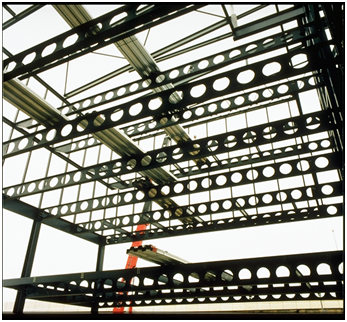- In 2005, Bitar et al. Published a paper that presents a methodology to determine the shear resistance, which is used in the cellular beam design software ACB+, but that was not fully explained since some details are confidential ,.
- Structural Design Software provides software created using Microsoft Windows Excel 2010/2013 or 2016 Office 365. Each spreadsheet contains formulas, reference code sections, and graphic drawings. 2 Cellular Beam Cellular Beam Design Based on AISC 360-10 / 16.

From 'CSI Analysis Reference Manual For SAP2000®, ETABS®, and SAFE™'The Shell element is a three- or four-node formulation that combines membrane and plate-bending behavior.' 'For each homogeneous Shell element in the structure, you can choose to model pure-membrane, pure-plate, or full-shell behavior. It is generally recommended that you use the full shell behavior (Shell - thick) unless the entire structure is planar and is adequately restrained.' Hi,I modelled 3 continuous beam with hinge support in etabs and compared it to manual calculations. The etabs and manual calculation almost have the same results for bending moment and steel reinforcement.The only difference is when we modelled the slab as shell type, it gives less bending moment and membrane type slab has more bending moment.When do we use the shell type slab and membrane type slab? I really appreciate if you could give a better explanation or example.How do we model gravity columns in ETabs?Thank you so much!Structech08RE: design of beam in etabs (Structural) 17 Mar 09 10:53.
Westok Plate Beam is used to design solid web or Cellular Westok Plate Beams (WPB). WPBs can also be designed in Tekla Structural Designer and Fastrak building Designer. Two different analysis approaches The Cellbeam Automate routine can be used to search for the minimum weight cellular beam which passes all design checks.

Mu'men Atoom from Jordan.I studied this case. I saw:- when we have solid slab ( slab on drop beams ), we must use membrane slab because it is more accurate than shell slab. ( membrane transfer loads from slab to beams by tributary area method then from beams to columns).-but when we have flat slab ( without drop beams ), we must use shell slab because it is more accurate than membrane slab. ( shell transfer loads from slab to columns directly by tributary area method ).Note: membrane transfers loads to horizantal boundary elements while shell transfers loads to boundary nodes of shell slab.good luck.AtoomusRE: design of beam in etabs.
FBEAM® is a fully featured composite beam design program that enables you to design composite and non-composite plain and cellular beams to multiple design codes. Design software that has an array of exciting and innovative features that substantially improve beam design efficiency. The first noticeable feature is the new interface - it's friendlier, familiar and much easier to use and navigate. Increased efficiency in design data entry. Common beam properties such as floor construction, loads, floor arrangements etc.
Are only created once. These properties can then be linked to multiple beams. Any changes made to a property changes all the beams that are referencing it, and the design output updates instantly. The software constantly analyses the whole project when a change is made so the status can instantly be assessed. Colour coded status for the beams lets the user instantly know if a beam passes, fails or has issues not allowing a design. 3D beam viewer showing cross section, elevation, floor plan and user controlled view allowing the beam to be rotated and viewed from any angle. SCI accredited BS5950 and Eurocode engineering module developed from the ground up that now incorporates the following new features:. Multiple load combination design.
Varying floor deck angles can be specified on either side. Distances to adjacent beams can vary at the left and right hand supports. Cantilever and fixed end beam designs now possible. Support for negative or upward loads can now be entered. Shear stud spacings can now be varied along the beam. End posts can now be checked automatically. Comprehensive user defined analysis settings options.
Cellular Beam Design Software Free
Includes the enhanced Beam Wizard™ - a fast and highly efficient 'one-pass' optimiser for beam designs in the fire and normal conditions that removes the need for iteration and determines the optimum solution in seconds. The cell generation and editing facility now makes an often complex and time-consuming task as simple as possible. The editor is versatile, flexible and sophisticated, but remarkably easy to use and allows the user to change the shape, position or spacing in a few simple mouse clicks. An all new regular cell generator allows a beam to be filled with regular cells that follow certain design rules allowing the cells sizes and positioning to dynamically change depending on the section they are applied to.